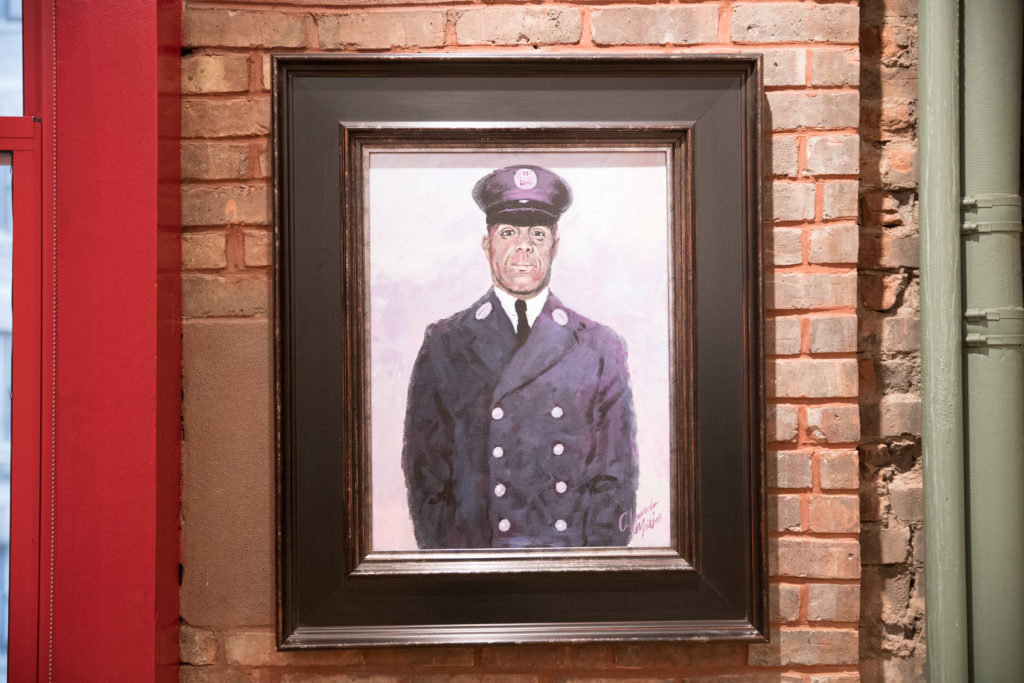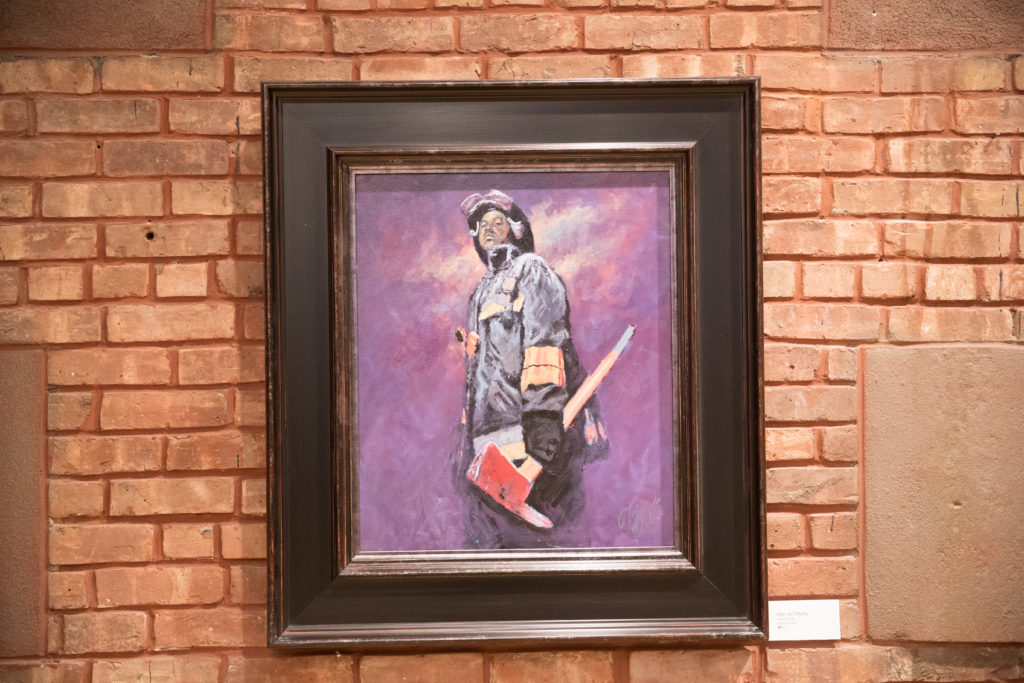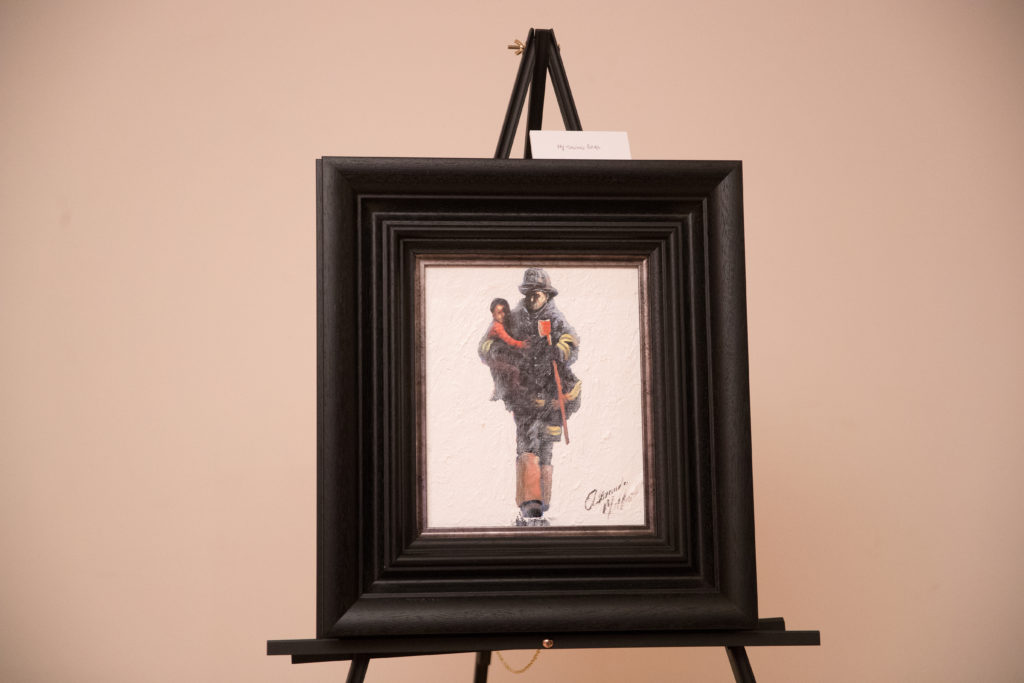The fire museum is not a museum filled with actual fire. It’s a collection of firefighter memorabilia with a gift shop downstairs, and, on the evening of April 3rd, a makeshift gallery on the third floor.
The Alexander Millar pop-up show, Everyday Heroes – NYC, celebrated the city’s firefighters along with the Scottish artist, which brought a fascinating crowd to the museum. Two men (one of them Millar) walked around the show in kilts, while a fashionable young woman in shiny heels took photographs, a man wearing skinny jeans and a gold, leafy ear crawler talked on his phone, and older visitors sat chatting on (turned off) radiators around the room’s perimeter. Millar’s oil paintings and pencil sketches served as the backdrop, each one depicting a different firefighter—some living, some deceased, and others that could be you.

Let me explain. Next to one painting titled We Could Be Heroes, a plaque explained that buyers would customize a nearly identical piece of art by adding “any name” to the firefighter in the painting’s jacket (the one on display simply read, “New York”).
Millar’s art is at once commercial and pure homage, namely to the firefighters who make up the Vulcan Society, which a press release for the event described as a “fraternal organization of black firefighters.” His work at the show celebrated the first African-American to rank as a firefighter officer, Wesley Williams (born in Manhattan, 1897) and Tracey Lewis, the second black female firefighter in New York City to make lieutenant. Lewis herself hung out at the show, along with Williams’s grandson.
An exhibition honoring firefighters in New York can’t ignore September 11th, and this one didn’t. Depicted in one oil painting, Keithroy Marcellus Maynard, a Vulcan Society executive member who helped aspiring black firefighters through their entry exams, was killed on 9/11. His mother, Pearl Maynard, attended the Everyday Heroes event. Regina Wilson, one of the first responding firefights during 9/11 and an advocate for women on the force, also came to survey Millar’s work.
So how does a white man in a kilt come to paint African -American firefighters?
In a strong Scottish accent, Millar told me about his inspiration for painting and what eventually led him to the US. He is originally from “a little place” called Kilmarnock, known solely, if at all, as the birthplace of Johnnie Walker scotch. “We went from breast milk to Johnnie Walker very quickly,” Millar said. About 25 miles south of Glasgow, Kilmarnock was a mining community when Millar grew up and a bit behind the rest of the world. “I was brought up in the ‘60s, but it felt more like the ‘40s…living in such an innocent time, it was lovely.”

Millar started painting around the time his father was dying, to bring some joy to an otherwise sad time. He would mostly draw people in his village, “the way an old man would get off a bike, the way a drunk would stagger home from the pubs.” His mission was to “capture the extraordinary out of ordinary events.”
After he started painting, Millar faced some tough times, living out of his car for a while (“I was a bum for a few weeks”) before gaining recognition as a painter. Eventually realizing that people enjoyed his work, he had an exhibition in Glasgow. His work sold out two days before the preview. “I said to the guy in Glasgow, ‘Does this normally happen?’ And he said, ‘It never happens.’” Two days later, an agent signed Millar, and he continued to paint for pay, at one point traveling as far from home as Hollywood.
Eventually, Millar signed with a UK publishing company whose contract kept him East of the Atlantic. But Millar wanted to paint Americans, so he starting “thinking about ways to turn the old men I paint into Americans.” He added baseball caps, mitts, “everything Americana” that came to mind (which seemed to be mostly baseball accessories). His American infatuation one day led to a conversation about September 11th, which got him thinking about the heroic firefighters who served that day. “I felt they were ordinary men and women…doing extraordinary work,” he said. He began drawing and painting them using photographs.
So Millar’s marketing team contacted the New York Fire Department to set up a show. His sales manager, Billy, went to deal with the logistics. He came back to Millar talking about Regina Wilson, whom he’d met and whose portrait Millar would eventually create for the exhibition. Billy talked about how she was the first female president of the Vulcan Society, how she was the only woman in her class of 300 firefighters in 1999, how she served her city on 9/11. “It’s such a male-dominated job, a male-dominated society, so a black woman being able to do as much and become the president of the Vulcan Society, that was a real achievement,” Millar noted. He wanted to showcase that achievement.
Interestingly, Millar rarely meets his subjects. “If I do paintings of someone I usually do photographs,” he said. “To be able to meet Tracey and Regina…I was nervous…but to meet them was lovely, and they’re such lovely people. When you think what they have to do as a job, it’s absolutely astounding.”

One of the paintings at the show depicted a firefighter whose back is to the viewer. He holds a large American flag and carries a little kid, holding a smaller version of the flag. On the back of the uniform, you can see Millar’s name written in careful capital letters.
“I try to add my voice to theirs through my art,” said Millar of his subjects. Looks like he succeeded.
Everyday Heroes- NYC will be at the New York City Fire Museum until April 6th. It will then move to the Millar Fine Art Pop-Up Gallery at 138 Wooster Street in Manhattan from April 7th to the 20th. For more information, click here.
